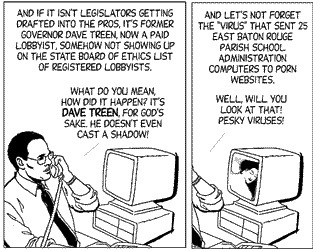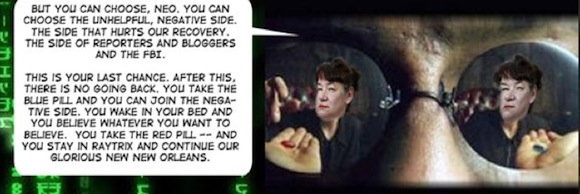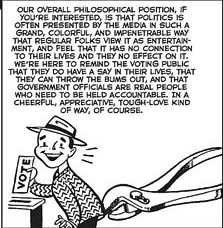“My fight is to get people to take back the reins of governance and remake their public world, to take it away from business interests and lobbyists and fat bastards.” — Greg Peters, from a 2008 Suspect Device blog post
Greg Peters, 50, passed away on Aug. 2, following emergency heart surgery. He was the ingenious creator behind the “Suspect Device” comic strip, a distinctive, scathing, and devastatingly funny commentary on the Louisiana political scene. For me, nothing came close. A “Suspect Device” strip could inform you, disturb you and make you laugh in fits.
Eight years ago, “Suspect Device” altered the way I thought about political change in New Orleans. In fact, it inspired subversive ideas about a political revolution here. I became excited. Maybe too excited.
So I wrote to Peters and asked if he would move into my house and help me wage a full-time, post-modern campaign against the “Uptown powers-that-be” — especially those who benefited from favorable treatment by the assessor’s office.
My particular target was assessor Al Coman, whose family had controlled the District Six office for the past 70 years. His assessments on prime Uptown real estate were scandalously low, and deprived the city of tax revenues.
In the summer of 2005, I sat down with Coman over the proverbial cup of coffee and orchestrated what I considered to be an ironic “Suspect Device” moment. All smiles, I said, “Mr. Assessor, the value you put on my house is far too … low. It’s off by at least 10 percent, and I’d like you to please correct the error.”
A surreal confusion ensued. Coman thought I had misspoken or didn’t understand how the process worked. He couldn’t get his mind around a perhaps unprecedented request to actually raise an assessment. Then I upped the ante:
“Mr. Coman, one more thing. My neighbor’s house is a mirror-image of my own — but her place hasn’t been revalued since 1982. Its market-value is over three times its assessment. Can you fix that too?”
Still mystified, Coman assured me that once the computers were upgraded, everyone would receive accurate assessments. Then he tapped on his keyboard and handed me a slip of paper with a number on it. He had reduced the already too-low assessment on my property by another 20 percent!
I was elated by this brazen “favor.” It was hard evidence of a busted system. I looked at it like it was a permission slip that would allow Peters and me to skewer the assessor with intense political irony.
I loved the surreal but hilarious discomfort in the assessor’s office, and wanted to convert that irony into a political campaign — “Suspect Device”-style.
I imagined scenes and scripts like the ones Peters created in his strip. One example: Candidate Moseley — me — greets a homeowner on St. Charles Avenue: “Good evening! Says here Coman assessed your mansion for $125K. Pretty stout number! But tell me, when’s the last time you upgraded your water pipes? Never!? Vote for me, and I’ll put you down for $70K, just to be on the safe side. Fair enough?”
I had no doubt Peters could distill such political mischief into eye-popping campaign graphics on T-shirts, signs and stickers. Hell, maybe they’d catch on as an in-crowd fashion statement and become a local sensation. Maybe this ironic movement would do more than create a stir. Maybe we’d actually win.
My euphoric vision dimmed a bit when Peters wrote back to gently decline my hospitality. His pastoral life in Lafayette entailed some commitments, he said: two toddlers, his wife, “and a couple of butt-ignorant hound dogs.” But he was up for a long-distance collaboration and offered to do all of my campaign graphics and branding. “You can run on the TLAR ticket (That Looks About Right),” he proposed. Alas, the ticket never took shape.
Our correspondence was on Aug. 26, 2005. The next day Peters wrote a post warning his New Orleans readers to “GET OUT NOW.” Hurricane Katrina was on its way, and Peters vividly described the Category 3 storm simulations he’d seen at a hurricane planning workshop. They were worse than you’d expect. Peters’ dire warnings on his “Suspect Device” blog crystallized my thoughts on the merits of evacuation. Several people I knew opted not to ride out the storm after they read his warnings about flooding and potential disaster.
After Peters’ death on Friday, journalist Jeremy Alford wrote: “When I first came across Greg’s art, I was willing to do whatever it took to work with him. So I started with flattery and wrote a profile on him for a local magazine.”
That’s not an exaggeration. I believe I felt the same way in August 2005, when I dreamed that Peters could create the first ironic campaign for assessor. Those who recognized Greg’s tremendous talents were drawn to him. Though Katrina scuttled my plans for political revolution, I did get to meet Peters when he agreed to be on a “Viewpoints” panel I moderated at the first Rising Tide blogger conference in 2006. Peters would become an organizer for the next five Rising Tide conferences, and designed the memorable graphics for our T-shirts and posters.
But Peters was blogging in Louisiana long before any of the other Rising Tide attendees. In fact, in the late ’90s he was one of the pioneers of online political discussion in the state. Peters would later team up with fellow trailblazers John Copes, creator of the enormously influential “Deduct Box” blog, and legislative watchdog C.B. Forgotston. The trio created a popular message board where cynics dissected the latest Louisiana political news — a haven where “internet kooks,” as then-Gov. Mike Foster memorably termed them, could ask impertinent questions. One example: Why does the state budget keep skyrocketing despite no growth in population?
Another innovation: Peters’ use of clip art for his “Suspect Device” spoofs. He took what today’s hipsters would uncleverly describe as “old-timey” images, and reinterpreted them as characters in a commentary on political events in Louisiana. It was magnificent. Peters wasn’t the first artist to exploit the energy created by mixing generic images with sarcastic dialogue, but he added an unmatched level of creativity and daring to the comic juxtapositions.
The Gambit obituary for Peters noted that “years before ‘Get Your War On’ popularized cartoons made from clip art, Peters was using intricate stock images to lampoon a host of national, state and local politicos.”
That’s not an incidental point. Peters had used clip-art to great effect since Suspect Device debuted in 1996 in the Times of Acadiana newspaper. (Gambit would pick up the strip in 1998.)

After 9/11, artist David Rees used the same clip-art images to create “Get Your War On,” which became wildly popular. Within weeks, millions were following Rees’ work. Rolling Stone picked up the strip, and Rees got book deals and notoriety. Media outlets called him a “super genius.” Admirers said his use of clip art was a “master stroke.”
Work by both Rees and Peters appeared in cartoonist Ted Rall’s book “Attitude 2: The New Subversive Social Commentary Cartoonists.” But Rees was grouped among “the well-known artists,” and Peters — who perfected (if he didn’t invent) the political clip-art comic genre — was described as a “cartoonist whose work is so good that it deserves much more attention.”
The apex of Peters’ career came when he compiled a multi-page cartoon for Fortune magazine depicting his trip to New Orleans two months after Katrina. Titled “Rise Above,” it chronicled the Crescent City’s initial fit-start attempts at recovery.
Peters didn’t have the timing or the luck that Rees did, though. Shortly after his big debut in Fortune, Gambit cut his cartoon back to a biweekly schedule. Peters aired his displeasure in a December 8, 2005 post, at his Suspect Device blog:
Gambit Weekly has offered to resume running Suspect Device on a regular schedule, but only half as often as before, every other week, in order to make way for the hip ‘n’ happening return of Bunny Matthews and Vic ‘n’ Nat’ly. So, after seven years, four NOLA press club awards, AAN [Association of Alternative Newsmedia] nominations, national exposure (even in this week’s Fortune, ironically), and not one increase in rates, I guess I’m increasingly irrelevant to Gambit’s readership, or at least its publishers. Better to fill the space with more jokes about hot saws on da ersters and Jazz Fest lines likened to nazi death camps. I’ve agreed to go every other week until I can find another outlet; if I can’t find another outlet, I’ll shut down the local SD and concentrate on a national version.
A few weeks later Peters submitted a startling mega-“Suspect Device” cartoon, which showed the holy manger scene recast with public officials involved in Katrina. Gov. Kathleen Blanco appeared as the Virgin Mary, she holds a baby President George W. Bush while Mayor Ray Nagin kneels in front of them. And so on. It was like the worst Christmas card ever, an ironic nightmare that would make even Hieronymous Bosch blanch. Deliciously offensive — yet somehow, amid this painfully absurd tableau, Peters would hold out hope for positive change. At the bottom of the piece he appended the words “No more. History begins now.”
That was quintessential Peters. He would twist the news inside out to discomfit and wake up the reader. He would drill into your mind with text and visuals that vibrated with ironic tension. But the running subtext to all his work — whether outrageous or hilarious — was the following question: What are we going to do about it?
We.
Gambit editor Kevin Allman recently compiled a “best of ‘Suspect Device’ ” collection and noted that Peters’ work ”took its sharpest form after Hurricane Katrina and the federal levee collapses.”
Indeed, who else but Peters would imagine an alternate world called the Raytrix, wherein then-Mayor C. Ray Nagin tries to tempt gadfly (and future Lens co-founder) Karen Gadbois into accepting the comfortable illusion that the city’s recovery appeared to be speeding along?

In 2010 Gambit dropped “Suspect Device” altogether, and no other media outlet had the cojones (or the spare cash) to pick up the strip. Now what are we left with?
Despite the “newspaper war” we hear so much about, all I see are reruns of lame national comic strips, with by-the-numbers jokes about the president or congress or the issue of the day. Isn’t there a place for a strip that really surprises and informs? And what about that little thing called humor? When’s the last time you opened an opinion page and laughed out loud at a local political cartoon — or even saw one?
Are we really settling for reprints of anodyne national comics, that just recap the news of the week or feed a bit of red meat to one partisan side or another?
We’re not likely to get another local artist of Peters’ caliber anytime soon. After all, strips like his violate the central maxim of most newspapers: Never risk confusing anyone (especially an assessor). But shouldn’t we demand, at minimum, something better than the current filler we see in The Advocate and The Times-Picayune?
Peters had immense talent and smarts, but he was a regular guy, too, and subject to the usual imperfections. For example, despite his Buddhist training, he never entirely overcame an intense hatred of selfishness and stupidity. Over the years we had a couple of dust-ups. And, like many of his admirers, I wasn’t always sure where I stood with him on a personal basis.
He was gentle — low-key but still very funny. I loved his stories: One night he stayed at our place and enthralled me and my wife with tales from Lafayette to Michigan’s Upper Peninsula. It was a great pleasure to see Peters enjoy Endymion with his two sons this year. There will be more personal tributes at a remembrance later this month. (Details here.)
But Peters’ lasting influence on me was through his strips. He reinterpreted the political scene so it wasn’t a distant entertainment. His strips were funny, but not in an easy way. They could offend, but not in a crass way. The punchlines were there, but you could never predict them.
Most importantly, though, Peters’ work inspired me to look at politics in new ways, and to think of novel approaches to changing New Orleans for the better — while enjoying a few laughs along the way.
Rest in Peace, Greg.



